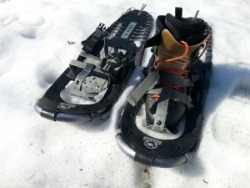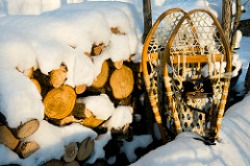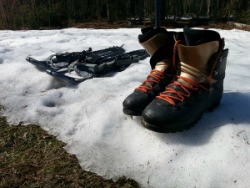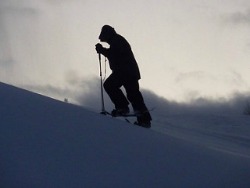 It’s almost time for winter here in the Northeast. That means lots of fun outdoor activities, but one of the easiest is snow shoeing. If you ever get the opportunity, I would highly recommend that you at least try it. It’s a great way to learn how difficult snow can be to navigate. When I was in New Brunswick, Canada last season, I had the opportunity to visit my uncle’s tipi. It’s about a mile out in the woods and there was three feet of snow on the ground. In some higher drift areas, the height of snow exceeded this. From time to time, we will get similar amounts of snow here in Maine.
It’s almost time for winter here in the Northeast. That means lots of fun outdoor activities, but one of the easiest is snow shoeing. If you ever get the opportunity, I would highly recommend that you at least try it. It’s a great way to learn how difficult snow can be to navigate. When I was in New Brunswick, Canada last season, I had the opportunity to visit my uncle’s tipi. It’s about a mile out in the woods and there was three feet of snow on the ground. In some higher drift areas, the height of snow exceeded this. From time to time, we will get similar amounts of snow here in Maine.
I snowshoe’d out there, shoveled it out, then decided to get some wood for a fire. I figured I’d try doing it without my snow shoes which turned into a forced march of less than a 100 yards. It’s hard to explain, but if you’ve been in deep snow you’ll know what I’m talking about. It’s hard to move around in deep snow. Anyway, I went back with my armload of wood and returned wearing my snow shoes.
History and Features of Snowshoes
Snowshoes have been in use for over 4,000 years. Ancient peoples used different kinds but our contemporary snowshoes originate from Native Americans. Older American webbed snowshoes were made from wood with gut and/or leather to form the webbing and bindings. Modern snowshoes are made from metal and other synthetic materials.
 In years past I’ve used beaver tail and bear paw snowshoes. I also used a pair made by one of my uncles that were long and thin – almost like a ski, but wider, which worked awesome on open snow. Beaver tails (my dad still uses them) are a generic snowshoe that work well in most places. I found the bear paws, which are a little smaller and rounder, to be good in tight quarters such as bushwhacking, but not as good as the beaver tails on open trail. With this being said, you could adequately use either type for any scenario. In fact, I preferred the bear paws my dad gave me until I bought the more modern Yukon Jack shoes.
In years past I’ve used beaver tail and bear paw snowshoes. I also used a pair made by one of my uncles that were long and thin – almost like a ski, but wider, which worked awesome on open snow. Beaver tails (my dad still uses them) are a generic snowshoe that work well in most places. I found the bear paws, which are a little smaller and rounder, to be good in tight quarters such as bushwhacking, but not as good as the beaver tails on open trail. With this being said, you could adequately use either type for any scenario. In fact, I preferred the bear paws my dad gave me until I bought the more modern Yukon Jack shoes.
Modern snowshoes are nice and have neat features that help in different environments. First, modern bindings are superior to older ones. Instead of a buckle and leather, they are made out of synthetics and easily snap into place. I’ve froze my fingers off many times trying get old bindings tight. Believe me, it is a relief to use more convenient, modern bindings.
Another great feature of modern snowshoes is the cleat that sits under your foot. This is really handy if you’re climbing a hill and need traction on hard snow or ice. I have crampons I wear for ice climbing, but snowshoes are better for overall snow travel.
There are many kinds of snowshoes on the market today. If you’re in the market for snowshoes, I’d suggest you talk to knowledgeable friends or a store expert. Some of them are really expensive, but my Yukon snowshoes cost about $80 and have lasted me ten years with no problems. I’ve hiked many mountains and forests with them and they are still in great shape. Find a pair that works for you and your situation.
Snowshoe Accessories
 Most people use gaiters that keep snow out of boots as they walk through deep snow. Gaiters are pieces of fabric and velcro secured under knee to the boot. Some folks like to use ski-poles. I now use a ski pole because there are situations where you’ll fall over without a little assistance. I like to have at least one hand free when walking to move bushes aside, pick stuff up, or what have you, so this was a good compromise for me. It’s like everything else, find what works for you and run with it.
Most people use gaiters that keep snow out of boots as they walk through deep snow. Gaiters are pieces of fabric and velcro secured under knee to the boot. Some folks like to use ski-poles. I now use a ski pole because there are situations where you’ll fall over without a little assistance. I like to have at least one hand free when walking to move bushes aside, pick stuff up, or what have you, so this was a good compromise for me. It’s like everything else, find what works for you and run with it.
Earlier this season I was walking through a frozen swamp. If you think walking through a swamp with alders is difficult, you should try it in the winter when all the trees are bent over from the weight of the snow. At one point I walked over a fallen tree to try and get past a particularly nasty deadfall. When I got to the other side, I fell off the tree and landed in a five foot snow drift. Luckily I had my ski pole with me, but I bent it all to hell using it to get out of that mess. Without it, I’d have worked much harder to escape from the drift.
Winter boots are pretty much up to you, but I prefer to wear a technical ice climbing boot when I’m doing winter activities. These boots are usually more expensive. While these are expensive, I get a great amount of use from them. For the record, I have an older pair of Scarpas and love them.
Snowshoeing is Tough
 In the early part of the snowshoeing season, I get leg cramps at night. Following some of these early expeditions, I’ve jumped out of bed gritting my teeth and massaging my thigh. After a couple times out, I adjust. I suggest you start going slow and walking short distances. Be patient; you’ll get the feel for it. Once your body adapts, you’ll be good to go. Even though snowshoes expedite travel over snow, you’ll need be in great shape. Snowshoeing is damned hard work. It is especially difficult if you’re wearing a pack, pulling a sled, breaking trail, or heaven forbid, doing all three at once.
In the early part of the snowshoeing season, I get leg cramps at night. Following some of these early expeditions, I’ve jumped out of bed gritting my teeth and massaging my thigh. After a couple times out, I adjust. I suggest you start going slow and walking short distances. Be patient; you’ll get the feel for it. Once your body adapts, you’ll be good to go. Even though snowshoes expedite travel over snow, you’ll need be in great shape. Snowshoeing is damned hard work. It is especially difficult if you’re wearing a pack, pulling a sled, breaking trail, or heaven forbid, doing all three at once.
When you go out there be prepared to have fun and work hard. Anybody else out there enjoy snowshoeing? Question? Comments? Sound off below!
Photos Courtesy of:
JarheadSurvivor
Dave Ruben Photo
Azmuskoka
Brigitte Malessa

5 comments
Snow shoeing is great fun and a good workout! Does anyone make a snow shoe/snow board combination, seems like a good combination but I have very little snow board experience! And ski poles (or walking staff) are a must in deep snow; a tripod (or quadripod) is a lot stabler and less fatiguing.
hey Jarhead, are tipis traditional for an eastern native? (native people are scarce in these parts, so there’s no one local that I can ask)
the local Lenape/Unami here supposedly lived in the “long house”, kind-of a “quonset hut”,
as I understood it. the tipi probably would shed the snow much better…
I have a few tarps, and some paracord, so far. (watching the yard sales, flea markets for a decent tent)
Hey Irish,
Yeah, tipi’s are actually from the plains Indians from what I understand. The wigwam or wikiup is more in lines with Eastern Indians.
Hi Roger – never heard of a combination snow shoe/board. I’ve done a lot of snowshoeing both with and without ski poles and they are a big help in deep snow. And yes, it’s a great workout.
Hey Roger you bring up an interesting point. I believe it was the Finn’s, back in the day, used one ski and one snowshoe when traversing deep snow in wooded country. Drove the Russians nuts trying to hunt them down.